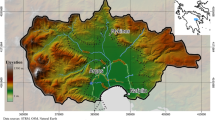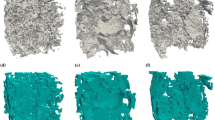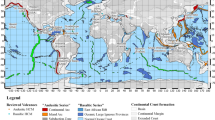Abstract
Karst aquifers can have a complex flow as a result of the formation of large conduits from dissolution features. As a result, a three-dimensional finite-difference groundwater flow model (equivalent porous media) may not apply as the dual porosity nature of karst features and the effects of turbulent flow cannot be directly simulated. Statistical analysis of karst hydrographs of the Trifilia aquifer in Greece showed the existence of a slightly karstified mass with high primary porosity that regulates the flow. An equivalent porous media model was developed to simulate the Trifilia karst aquifer using MODFLOW. Steady state and transient state calibration gave encouraging results for the equivalent porous media approach, which does not consider pipe flow or turbulence. Detailed hydrogeological research conducted in the area helped define the aquifer hydraulic conductivity zones and extent; and flux to/from the aquifer. Only hydraulic conductivity and specific yield were adjusted during calibration, as the flux to/from the system was considered known and applied as boundary conditions. Small mean absolute and RMS piezometric head error of the model under both steady and transient state conditions were achieved.










Similar content being viewed by others
References
Al-Assa’d TA, Abdulla FA (2010) Artificial groundwater recharge to a semi-arid basin: case study of Mujib aquifer, Jordan. Environ Earth Sci 60:845–859
Alvarez MP, Trovatto MM, Hernández MA, González N (2011) Groundwater flow model, recharge estimation and sustainability in an arid region of Patagonia, Argentina. Environ Earth Sci (in press)
Angelini P (1997) Correlation and spectral analysis of two hydrogeological systems in Central Italy. Hydrol Sci J 42(3):425–438
Angelini P, Dragoni W (1997) The problem of modelling limestone springs: the case of Bagnara (North Apennines, Italy). Ground Water 35(4):612–618
Barrett ME, Charbeneau RJ (1996) A parsimonious model for simulation of flow and transport in a karst aquifer. Center for Research in Water Resources Technical Report 269, p 149
Budge TJ, Sharp JM (2009) Modeling the usefulness of spatial correlation analysis on karst systems. Ground Water 47(3):427–437
Choquette PW, Pray LC (1970) Geologic nomenclature and classification of porosity in sedimentary carbonates. Am Assoc Petrol Geol Bull 54(2):207–250
Doherty J (1994) PEST. Model-independent parameter estimation. User’s manual. Watermark Numerical Computing, Australia
Dufresne DP, Drake CW (1999) Regional groundwater flow model construction and wellfield site selection in a karst area, Lake City, Florida. Eng Geol 52(1–2):129–139
EMRL (1999) Groundwater modeling system. Brigham Young University, Environmental Modeling Research Laboratory, Utah
Fleury P, Plagnes V, Bakalowicz M (2007) Modelling of the functioning of karst aquifers with a reservoir model: application to Fontaine de Vaucluse (South of France). J Hydrol 345:38–49
Florea LJ, Vacher HL (2006) Springflow hydrographs: eogenetic vs. telogenetic karst. Ground Water 44(3):352–361
Greene EA, Shapiro AM, Carter JM (1999) Hydrogeologic characterization of the Minnelusa and Madison aquifers near Spearfish, South Dakota. US Geological Survey Water-Resources Investigations Report 98-4156, p 64
Halihan T, Wicks CM (1998) Modeling of storm responses in conduit flow aquifers with reservoirs. J Hydrol 208:82–91
Hill ME, Stewart MT, Martin A (2010) Evaluation of the MODFLOW-2005 conduit flow process. Ground Water 48:549–559
Huntoon PW (1994) Is it appropriate to apply porous media groundwater circulation models to karstic aquifers? In: El-Kadi AI (ed) Groundwater models for resources analysis and management. Pacific Northwest/Oceania Conference, Honolulu, pp 339–358
Jeannin PY (2001) Modeling flow in phreatic and epiphreatic karst conduits in the Holloch Cave (Muotatal, Switzerland). Water Resour Res 37:191–200
Jemcov I, Petrič M (2009) Measured precipitation vs. effective infiltration and their influence on the assessment of karst systems based on results of the time series analysis. J Hydrol 379:304–314
Karst Waters Institute (2007) Karst Waters Institute—Home. Leesburg, Virginia. http://www.karstwaters.org/index.htm. Cited 25 October 2007
Keeler RR, Zhang YK (1997) Modeling of groundwater flow in a fractured-karst aquifer in the Big Springs Basin, Iowa. Geol Soc Am Abs Programs 29(4):25
Kourampas N, Robertson AHF (2000) Controls on plio-quaternary sedimentation within an active fore-arc region: Messenia Peninsula (SW Peloponnese), S. Greece. In: Panayides I, Xenophontos C, Malpas J (eds) Proceedings of the third international conference on the geology of the Eastern Mediterranean, pp 255–285
Kuniansky EL (1993) Multilayer finite-element model of the Edwards and Trinity aquifers, Central Texas. In: Dutton AR (ed) Toxic substances and the hydrologic sciences. American Institute of Hydrology, pp 234–249
Kuniansky EL, Holligan KQ (1994) Simulations of flow in the Edwards-Trinity aquifer system and contiguous hydraulically units, west-central Texas. US Geological Survey Water-Resources Investigations Report 93-4093, p 40
Kuniansky EL, Fahlquist L, Ardis AF (2001) Travel times along selected flow paths of the Edwards aquifer, central Texas. In: Kuniansky EL (ed) US Geological Survey Karst Interest Group Proceedings, St. Petersburg, US Geological Survey Water-Resources Investigations Report 01-4011, pp 69–77
Larocque M, Mangin A, Razack M, Banton O (1998) Contribution of correlation and spectral analyses to the regional study of a large karst aquifer (Charente, France). J Hydrol 295:217–231
Laronne Ben-Itzhak L, Gvirtzman H (2005) Groundwater flow along and across structural folding: an example from the Judean Desert, Israel. J Hydrol 312:51–69
Martínez-Santos P, Andreu JM (2010) Lumped and distributed approaches to model natural recharge in semiarid karst aquifers. J Hydrol 388:388–389
Martínez-Santos P, Martνnez Alfaro PE, Murillo JM (2005) A methodology to estimate the artificial recharge capacity of the Crestatx aquifer (Majorca, Spain). Environ Geol 47(8):1155–1161
Martínez-Santos P, Llamas MR, Martνnez-Alfaro PE (2008) Vulnerability assessment of groundwater resources: a modelling-based approach to the Mancha occidental aquifer, Spain. Environ Model Soft 23(9):1145–1162
McDonald MG, Harbaugh AW (1988) A modular three-dimensional finite-difference ground-water flow model. US Geological Survey Open-File Report, Washington
Padilla A, Pulido-Bosch A (1995) Study of hydrographs of karstic aquifers by means of correlation and cross-spectral analysis. J Hydrol 168:73–89
Panagopoulos G (2004) Environmental hydrogeological research of SW Trifilia aquifers. Dissertation, University of Patras, Greece
Panagopoulos G, Lambrakis N (2003) Groundwater responses to recharge and human-induced stresses in the Trifilia karst aquifer, Greece. In: Krásný J, Hrkal Z, Bruthans J (eds) Proceedings of international conference on “Groundwater in Fractured Rocks”, IHP-VI, Series on Groundwater No. 7, pp 167–168
Panagopoulos G, Lambrakis N (2006) The contribution of time series analysis to the study of the hydrodynamic characteristics of the karst systems: application on two typical karst aquifers of Greece (Trifilia, Almyros Crete). J Hydrol 329:368–376
Perrier R (1980) Geological map of Greece, scale 1:50,000, Filiatra sheet, IGME, Athens
Pulido-Bosch A (1993) The karstic aquifer of the Torcal de Antequera (Malaga). In: Pulido-Bosch A (ed) Some Spanish karstic aquifers. University of Granada, pp 37–49
Pulido-Bosch A, Padilla A, Dimitrov D, Machkova M (1995) The discharge variability of some karst springs in Bulgaria studied by time series analysis. Hydrol Sci J 40(4):517–532
Quinlan JF, Davies GJ, Jones SW, Huntoon PW (1996) The applicability of numerical models to adequately characterize ground-water flow in karstic and other triple-porosity aquifers. In: Ritchy JD, Rumbaugh JO (eds) Subsurface fluid-flow (ground-water and vadose zone) modeling, ASTM STP 1288. American Society for Testing and Materials, pp 114–133
Quinn JJ, Tomasko D, Kuiper JA (2006) Modeling complex flow in a karst aquifer. Sediment Geol 184:343–351
Ritorto M, Screaton EJ, Martin JB, Moore PJ (2009) Relative importance and chemical effects of diffuse and focused recharge in an eogenetic karst aquifer: an example from the unconfined upper Floridan aquifer, USA. Hydrogeol J 17(7):1687–1698
Sanford W (2002) Recharge and groundwater models: an overview. Hydrogeol J 10(1):110–120
Scanlon BR, Mace RE, Barrett ME, Smith B (2003) Can we simulate regional groundwater flow in a karst system using equivalent porous media models? Case study, Barton Springs Edwards aquifer, USA. J Hydrol 276:137–158
Sepulveda N (2002) Simulation of ground-water flow in the intermediate and Floridan aquifer systems in peninsular Florida: US Geological Survey Water-Resources Investigations Report 02-4009, p 130
Shoemaker WB, Cunningham KJ, Kuniansky EL, Dixon J (2008) Effects of turbulence on hydraulic heads and parameter sensitivities in preferential groundwater flow layers. Water Resour Res 44:W03501. doi:10.1029/2007WR006601
Svensson U (2001) A continuum representation of fracture networks, Part I: method and basic test cases. J Hydrol 250:170–186
Teutsch G (1993) An extended double-porosity concept as a practical modelling approach for a karstified terrain. Hydrol Sci Publ 207:281–292
Teutsch G, Sauter M (1998) Distributed parameter modelling approaches in karst hydrological investigations. Bull Hydrogeol 16:99–110
Thornthwaite CW (1948) An approach toward a AUPEL rational classification of climate. Geol Rev 38:55–94
Thornthwaite CW, Mather JR (1957) Instructions and tables for computing the potential evapotranspiration and the water balance. Publ Clim 10:183–311
Thrailkill J (1986) Models and methods for shallow conduit-flow aquifers. In: Proceedings of the environmental problems in karst terraines and their solutions conference. Bowling Green, Ky., National Water Well Association, pp 17–31
Vacher HL, Mylroie JE (2002) Eogenetic karst from the perspective of an equivalent karst medium. Carbon Evapor 17(2):182–196
Wanakule N, Anaya RA (1993) A lumped parameter model for the Edwards aquifer. Texas Water Resources Institute, Technical Report No. 163, p 84
Worthington SRH, Schindel GM, Alexander CEJ (2001) Aquifer scale properties for hydraulic characterization of carbonate aquifers. Geol Surv Am Abs Program A-411
Xi H, Feng Q, Liu W, Si J, Chang Z, Su Y (2010) The research of groundwater flow model in Ejina Basin, Northwestern China. Environ Earth Sci 60:953–963
Yidana SM (2011) Groundwater flow modeling and particle tracking for chemical transport in the southern Voltaian aquifers. Environ Earth Sci 63:709–721
Zhang YK, Bai EW, Libra R, Rowden R, Liu H (1996) Simulation of spring discharge from a limestone aquifer in Iowa. Hydrogeol J 4:41–54
Author information
Authors and Affiliations
Corresponding author
Rights and permissions
About this article
Cite this article
Panagopoulos, G. Application of MODFLOW for simulating groundwater flow in the Trifilia karst aquifer, Greece. Environ Earth Sci 67, 1877–1889 (2012). https://doi.org/10.1007/s12665-012-1630-2
Received:
Accepted:
Published:
Issue Date:
DOI: https://doi.org/10.1007/s12665-012-1630-2




